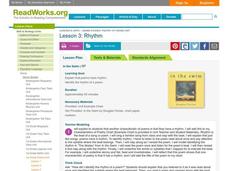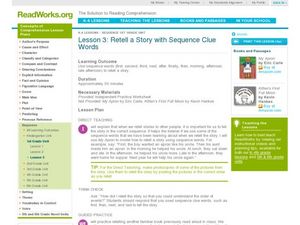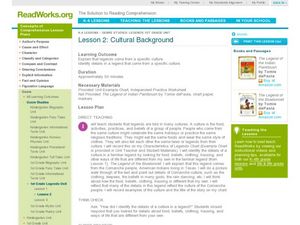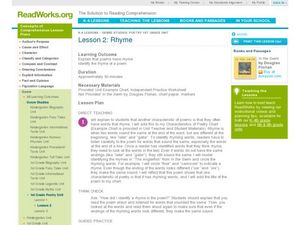Curated OER
Lesson 3: Cause and Effect Relationships
The Gunniwolf is a book full of events that get kids asking why and what. They note several events on a chart, and then discuss how they think the instructor is able to determine the causes and effects they find. They continue reading...
Curated OER
Hyperboles
Want to see the best instructional activity is the entire universe? Who doesn't love to exaggerate now and then? Get your class cozy with hyperbole as you read the story My Dad by Anthony Browne. During the reading you'll chart and...
Curated OER
Nature
Discuss what makes a myth with your class as you read two titles that exemplify the genre. Two myths that explain events in nature are read and charted, focusing on details from the text. The lesson culminates in a practice activity...
Curated OER
Rhythm
One of the most fun characteristics of a poem is rhythm! Little ones will clap along as you read a poem, to determine the rhythm of the piece. The book In the Swim is used throughout the lesson; it contains fish themed poems that kids...
Curated OER
Identifying Problems and Solutions in the Story
Students explore story structure. For this Groundhog's Day story structure literacy lesson, students listen to the story Groundhog Stays Up Late by Margery Cuyler, then pause half way through the story to identify the problem and...
Curated OER
Lesson 3: Retell a Story with Sequence Clue Words
First graders evaluate sequence words. In this order of events lesson, 1st graders practice using sequence words to retell a story. They do guided practice with the teacher retelling a story they have read as a class and then try it...
Curated OER
Effects
Students explore cause and effect. In this reading comprehension lesson plan, students define and describe examples of "cause and "effect." Students listen to Chrysanthemum by Kevin Henkes and contribute examples of cause and effect...
Curated OER
Identifying When Using Evidence from the Text
First listen to the story The Meanest Thing to Say and then answer question regarding when the story takes place. Using evidence from the text, text clues and pictures to order events and find the time frame of the story is what this...
Curated OER
Lesson 1: Identifying Information
Factual books about animals are great for sparking interest in non-fiction text. Little ones will love learning about the foods animals eat as they practice identifying facts in a text. They chart the information they've learned by...
Curated OER
Retelling Problems and Solutions in Chronological Order
First graders discover how to retell problems and solutions in a story in chronological order. In this chronological order lesson, 1st graders use graphic organizers to record information. Students then use this information to sequence...
Curated OER
Sorting into Three Groups
First graders discuss categorizing items into different groups. In this language arts lesson, 1st graders read a story, chart three categories from the book and describe examples from the book that fit in each category.
Curated OER
The Structure of Poems
First graders listen to and view the structure of various insect poems. In this structure of poems lesson, 1st graders compare to other text they have read. Students complete a vocabulary exercise about the word bold. Students will...
Curated OER
Identifying Opinions with Signal Words
First graders identify opinions within a text. In this language arts lesson, 1st graders discuss the definition of opinion. Students identify words that signal opinions and work together to identify opinions within the text.
Curated OER
Cultural Background
First graders pick out cultural details from the story The Legend of the Indian Paintbrush. In this culture lesson plan, 1st graders discuss how legends come from cultures that have traditions.
Curated OER
Rhyme
First graders explore rhyme through the use of poems. In this language arts lesson, 1st graders read poems and identify words that rhyme within the poem. Students circle the rhyming words within a poem as they listen.
Curated OER
Lesson 1: Actions
Action is what characters in books do or say. Little ones discuss what actions are and then examine the book David, No! to identify them. As they read through the book, they chart all of David's actions. They write a sentence and draw a...
Curated OER
Form an Opinion Based on Facts
Explore fact and opinion through higher level thinking and literacy. Kids listen to the beginning of A Picture Book of Helen Keller by David A. Adler and identify facts in the text. They follow along as the teacher models how to form an...
Curated OER
Table of Contents and Index
Have your class investigate the use of a table of contents and index to find information. They identify characteristics of informational books and add them to a chart, then demonstrate how to use the index and table of contents by trying...
Curated OER
Lesson 3: Gods and Goddesses
Exploring and characterizing myths can be fun. The class reads a version of "Pandora's Box," add to their myth chart, and discuss how gods and goddesses are commonly used in mythology. They work in groups to identify the gods and...
Curated OER
Sequence Clue Words (Part 1)
Does your class know they can use sequence words such as, next, finally, after, and then to better understand the sequence of a story? First they discuss sequential order and sequence words, then they look for sequence words as they read...
Curated OER
Opinion
An important concept for youngsters to learn is that there is a difference between facts and opinions. Use Kirsten Hall's Animal Touch to introduce the idea that an opinion is how one feels or thinks about something and that others are...
Curated OER
Identifying Facts and Forming Opinions
Kirsten Hall's animal books provide learners with an opportunity to practice forming statements of opinions and factual statements. Using sentence starters such as "I learned. . ." and "I think. . ." class members craft sentences cite a...
Curated OER
Fantasy Details
Students identify fantasy details from a fairy tale they have read and give an explanation of how they know it is a fantasy detail. In this fantasy detail lesson plan, students make a list from the fairy tale Little Red Riding Hood.
Curated OER
Sorting Based on Character Traits
Characters from a story can be sorted by their traits, just like shapes or objects can. First the children list several character traits on a chart, they read a familiar story, and then sort the characters by their friendly or unfriendly...

























